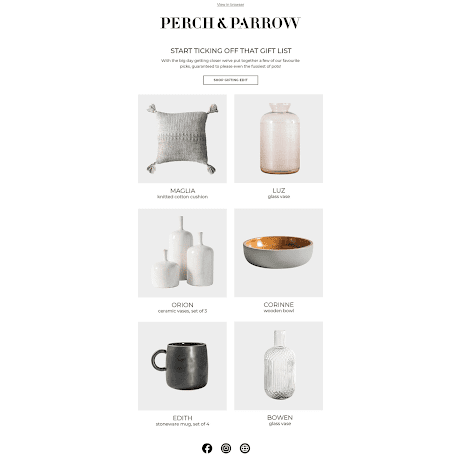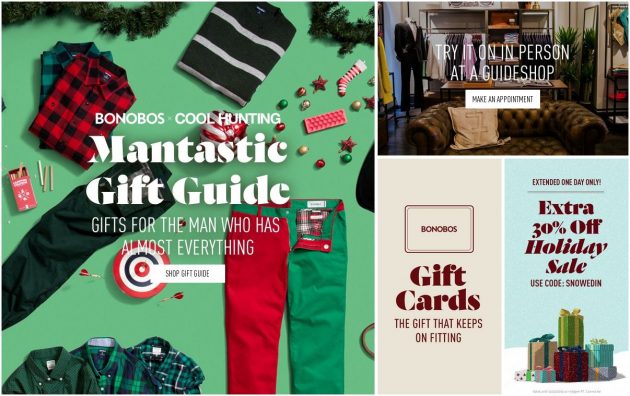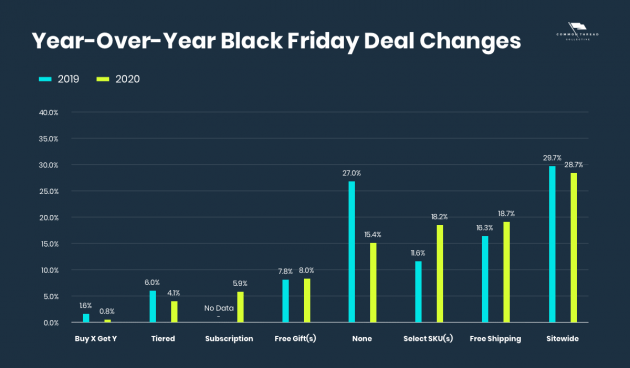Go, go, go! The biggest shopping days are upon us. But never fear; there is still time to make adjustments to your holiday strategies so that you have your best peak season shopping days yet.
We reached out to the best of the best eCommerce and online marketing experts to find out which strategies they suggest you should be using over the upcoming holiday shopping season. Including from these gurus:
eCommerce Pros and Marketing Experts
So without further ado…Here are 15+ winning holiday marketing strategies from digital marketing, SEO, and eCommerce gurus to help you make more sales this holiday season.
1. Plan to Go All-In on Customer Service Despite How Busy Your Store Is
According to Adi Brittan, the CEO and Founder of OwnerListens, the number one holiday strategy is to install systems to ensure you’re not just increasing sales, but increasing your list of loyal customers for long-term extended sales and growth. And how do you do that? By investing big in customer service optimization.
Adi Bittan: CEO and Co-Founder of OwnerListens
“During the holidays, many companies become overwhelmed by the volume of incoming customer requests. As a result, service suffers, customers complain, and your staff become frustrated.
Keep in mind that when people purchase gifts, they are more nervous than when they purchase for themselves. Add to that an explicit delivery deadline, and you get very stressed out customers. Coupled with higher holiday volumes, this can strain your service staff.
While they make short-term sales, companies that don’t prep for it lose the opportunity for loyal, repeat business. It’s especially unfortunate considering all the time and money spent on holiday marketing.”
What does Adi suggest doing to ensure you are prepared for the holiday rush?
- Review your FAQ and support templates
- Over-communicate things like expected delivery times
- Offer gift wrap options and special return policies
- Refresh staff training, add tactics for stress management and dealing with difficult customers
- Ensure support channels are clearly listed on your site; otherwise, customers will go to Facebook or Twitter and list your support channels in order of efficiency
2. Invest Heavily in Remarketing PPC Campaigns
Digital marketing strategist, Chris Makara, says it’s all about remarketing this holiday shopping season. This means increasing your eCommerce ad portfolio to include additional remarketing campaigns designed to get promotions in front of the eyes of previous customers and traffic that knows your brand well.
Chris Makara: Digital Marketing Strategist Skilled in SEO, Social Media, and Analytics
“My number one tip for small eCommerce businesses during the holiday season is to rely heavily on remarketing. With remarketing, you’ll be able to aggressively promote your product or business to people who have already shown interest.
Basically, you should increase the frequency, and ad spend to these users until they convert/buy from you.
Just be sure to exclude conversions from your remarketing campaigns, so you aren’t wasting money on people who have already purchased. Also, be sure to dial back the spend and aggressiveness of the campaigns once the holiday season is over.”
So what to do?
Here are four quick eCommerce remarketing tips for the holidays:
- Start marketing early
- Target your entire eCommerce marketing sales funnel
- Vary your remarketing campaign
- Update and increase your PPC strategy
If you’re using advanced PPC management services, such as Traffic Booster, you can reach out to your account manager to increase your advertising budget and add more remarketing campaigns. Alternatively, for those DYI-ing your holiday campaigns, you can manually add and optimize campaigns across all your eCommerce advertising channels.
Bonus Content: Google Ads vs. Facebook Ads vs. TikTok Ads
3. Go Back to Basics and Upgrade Your Lead Generation Foundations
Now is the time you should be focusing on lead generation. In fact, most brands start as early as August to drive brand awareness and grow lists (AKA, lead generation) in time for the holiday season.
The founder of AppSumo, Noah Kagan, is no stranger to optimizing lead generation. Here’s his top holiday strategy for online retailers.
Noah Kagan: Internet Entrepreneur and Founder of AppSumo
“90% of eCommerce visitors don’t buy on their first visit. Most of them are comparing your product and price with other online stores. The possibility that they come back to your site — and make a purchase — is incredibly low once they leave your store.
This number only rises during the holiday season. Yes, you get more people visiting your site, but it doesn’t help your business when the majority of traffic never becomes your customers.”
So, what to do?
According to Noah Kagan, to make the most out of the holiday season, you should be focusing on building your email list. Here’s how he suggests eCommerce brands do it:
- Create an email opt-in form with a compelling offer or discount in exchange for your visitors’ email address.
- Email your subscribers regularly to build the relationship, starting with a good welcome email.
- Send them special offers and start turning them into your customers.
Building an email list doesn’t only help boost your revenue during the holiday season. You also get to communicate with (and sell to) your prospective customers after the holiday season is over.
Bonus Content: The 2022 Email Deliverability Guide for eCommerce Businesses
4. Review and Update Your Email Marketing Holiday Season Strategy
In a Pathwire report, 77% of B2C sellers agreed that their Black Friday emails resulted in significant ROIs. It should be no surprise that Shopify Plus expert Kurt Elster advocates big for eCommerce brands optimizing holiday season email marketing strategies.
The Founder of Ethercycle and host of The Unofficial Shopify Podcast suggests sending as many as 21 to 30 emails during the holiday season to seize the opportunity.
Kurt Elster: eCommerce Guru, Shopify Plus Expert, Founder of Ethercycle, and host of The Unofficial Shopify Podcast.
“The average eCommerce shop sent 15 emails for previous holiday seasons. Some specific industries, like fashion and apparel, sent up to 30 emails per subscriber.
How many emails should you send?
Like all things, the answer is, it depends. What are you comfortable with? What is typical in your industry?
Look in your inbox for last year’s holiday emails. How many did you get from your favorite brands?
As a safe number, I would send a minimum of ten, but ideally, 21–30. This is the one season when it’s appropriate, so let’s seize the opportunity.
Regardless of how many emails you choose to send, implement automation to segment your campaigns, so they’re only sent to customers that haven’t purchased in the last 15 days. This ensures that recent buyers aren’t alienated by too many emails or making a purchase at full price and missing a deal.”
Here are some holiday email marketing strategies and hacks worth considering in 2022:
- Don’t focus only on the big holidays; instead, send micro promotions and marketing emails for lesser-known holidays
- Add as much segmentation and personalize your holiday email campaigns as much as possible
- Invest in eCommerce automation tools for marketing
- Add as much value as possible to your customer’s inbox (holiday shopping guides are a good place to start)
[Source: Sendinblue]
5. Understand That Higher CTCs Also Mean ROAS
When you consider that Shopify retailers processed a whopping $3.1 million per minute last year, it shouldn’t surprise you that now is not the time to skimp on ad spend. Despite this, eCommerce marketing expert and co-founder of StoreYa Eyal Reich says that too many eCommerce sellers are reluctant to increase budgets to compensate for the increased CPCs.
Eyal Reich: COO & Co-Founder of StoreYa
“Many merchants are afraid to advertise during the holiday season, thinking the cost per click is higher. They are right, but they are also wrong.
Although CPC does increase by 9% during the holidays, ROI actually increases by 36%, which means that this is THE time to advertise. We reached this number by analyzing $50M worth of the holiday season sales. Read this case study.”
The bottom line is that activating seasonal budgets is key to driving profitable growth.
So, how to increase your advertising budget the right way? Here are three steps:
- Take advantage of channel automation campaigns such as Google and Facebook’s Dynamic and Responsive campaigns
- Increase budgets, so they have enough wiggle room for rapid query and coverage growth
- Adjust eCommerce ad campaign budgets across all channels to cater to high-value peak shopping days
You can read about these and more hacks in our 2022 Holiday Shopping Google PPC Strategy for eCommerce Retailers post.
6. Stay Front and Center in the Minds of Customers
Peak holiday shopping days are not the time to be shy. According to best-selling author David J. Bradley, eCommerce brands need to be sure they are continuous. Here’s his top eCommerce marketing suggestion for the peak shopping holiday season.
David J. Bradley: Digital Transformation Expert, Best-Selling Author, and Speaker
“Companies need to stay in front of their customers all throughout the holiday season.
They need to always be a click away so that they are available when their customers are ready to buy. During holidays, there is a mix of impulse buys and thoughtful buying processes, so you need to be ready for both for your consumers.
The best way to do this and to make sure you are always available and top of mind is through ‘retargeting.’
With retargeting, your brand is prominently displayed in front of people who have engaged with you in some way, like visiting your website or a specific product page. This allows you to focus on a ‘warm’ audience, so you are there when they are ready to buy.”
Here are some more ways you can ensure your brand and products are top of mind this holiday season:
- Personalize your marketing as much as possible
- Have an active social media content strategy
- Offer VIP promotions or services (such as gift wrapping)
- Add a much value to your content and social media marketing strategies
7. Define Your Hard Limit for Your Marketing and Budget KPIs
Yes, you need to increase budgets and plan for more marketing spend overall. However, that’s not to mean you shouldn’t be setting some limits. Mark Rushworth suggests keeping a very close eye on your profitability throughout peak holiday shopping days, as your goal should be profit, not total turnover.
Mark Rushworth: SEO, Digital Media, and eCommerce Expert
“In three words, ‘watch your profitability.’ Irrespective of the channel used, whether it be paid, social, email, or organic, you need to make sure that you control your budget and focus on what is going to deliver the best ROI.
This may mean cutting back on PPC for your least popular products to maximize what generates the most profit, stopping display temporarily, ramping up organic outreach on key lines three or four months in advance of the festive period, or jumping on CRO to improve conversions by a few percent and potentially doubling sales.
Profit, not turnover, should be your goal unless you’re brand building, in which case turnover may be more desired. Ask your suppliers to give you this data and work out where your budget is best spent and make a dispassionate but informed decision.”
Ultimately, you want to ensure you set your target ROAS for all channels (PPC, email, onsite promotions, etc.) ahead of the busy shopping days. If you’re not using PPC management software, then you will want to set this manually for each channel. For instance, making sure you set up target ROAS bidding for Shopping campaigns.
As a reminder, your ROAS is the total revenue generated from advertising divided by the total ad spend, times 100. (ROAS = Revenue from Advertising / Ad Spend x 100)
Bonus Content: 54 Top eCommerce KPIs to Monitor for Max Success
8. Don’t Push Aside the Potential of Storytelling
Now’s not the time to forgo the storytelling aspect of your social media marketing. But, whether it’s an Instagram Live or a Facebook ad for eCommerce, don’t skimp on value — especially when trying to reach new audiences. This is something social marketing strategist, Ted Rubin, knows all about.
Ted Rubin: Social Marketing Strategist, Keynote Speaker, Brand Evangelist, and Acting CMO of Brand Innovators
“Story is important: remember the power of storytelling, and use it in your communications. The holidays offer up so many great opportunities to tell your story in a way people will care. People can’t resist a good story. It’s an emotional connection bridge that is built into our human DNA. Social enhances this connection by allowing more consumers to share more stories about more of the products they see, buy, and use.
Another thing to remember about stories is that people are already having conversations about your brand, and you can’t control that. Companies who try to stem the tide of stories they have not embraced by trying to control the message find this out the hard way. However, you can influence the kind of stories that are told about you by being involved in the conversation, transparent in your use of social media, and responsive to the needs of your customers, both online and offline… #NoLetUp!”
If you look at winning holiday promotion examples for eCommerce retailers, they all have a point of view or value story. Bonobos were able to create limited-time holiday deals, tiered options, and high-value discounts that didn’t just push AOVs, but established brand authority through high-value content.
9. Run Promotions That Speak Directly to Your Target Shoppers
Do you know what drove your revenue last year? Have you tapped into what your shoppers want? John Lincoln from Ignite Visibility highly recommends that eCommerce brands take a deep dive into analytics and create highly niche promotions that speak specifically to your shoppers in a language they will understand. Here’s how he recommended you choose your promotions.
John Lincoln: Co-Founder and CEO of Ignite Visibility
“Before you even start, review your analytics from last year. Make sure to get a clear understanding of what drove the most revenue for you, so you can double down on those efforts.
My number one marketing strategy tip is to create a clear promotion that everyone can understand.
Either choose one product, a site-wide discount, refer-a-friend campaign, etc. and develop a marketing strategy around that.
- To select this promotion, look at what will drive the most revenue for your business and then look at all the campaigns you have run over the past year. Also, review your competitors’ campaigns.
Once you have your campaign selected, start promoting it at least six weeks before the holidays.
- Do a series of press releases, blog posts, guest posts, Facebook ads, Google AdWords ads, email marketing campaigns, etc. Make sure to have a marketing plan that promotes the campaign from all angles.
I also highly recommend YouTube ads. They are very inexpensive and will help you get the word out about the promotion. The in-stream ads work very well.
Finally, make sure you add a countdown timer on your site that shows when the deal is coming to a close. That always helps conversion rates.”
Ultimately, you want to make sure your promotions are simple, clear, and to the point, and designed specifically for your target audience. Here are the most popular ones based on one study over the Black Friday Cyber Monday season:
- Sitewide
- Free shipping
- Select SKUs
- Free gifts
- Subscriptions
- Tiered
- BOGO (Buy One, Get One)
10. Combine the Human Touch with the Power of AI
One of the most critical factors of a converting holiday strategy is personalization: Giving your campaigns that human touch that speaks directly to the minds of your shoppers. But, says Sam Hurley (digital marketer and founder of the OPTIM-EYEZ platform), brands need the power of Artificial Intelligence (AI) to drive home personalization success.
Sam Hurley: Digital Marketer and Founder of the OPTIM-EYEZ Platform
“Personalization is the most critical component of any holiday marketing campaign. Make your visitors, community base, and customers really feel special and get to know them properly (at scale, when required).
This ‘human’ touch has the power to set you apart from the masses of competition — and ironically, Artificial Intelligence (AI) is the enabler.
Serve content, offers, and product news that are timely and highly specific to the tendencies and past behaviors of your audience, on an individual level…including their current stage in their own unique buyer journey, while taking into account their status (i.e., active, dormant, infrequent, etc.). Combine AI with personable customer service for a winning combination!”
PPC automation tools are a great place to start. Otherwise, check out these list posts for a wide variety of options.
- 16+ eCommerce Automation Tools to Boost Online Sales and Profits
- Dominate Your eCommerce Sales with These Best Shopify Apps [2023]
11. Implement Your Holiday Marketing Strategy as Early as Possible
Plan ahead! Don’t wait until the last minute to start your holiday marketing, preparing your backend admin, gearing up your customer support systems, and fixing your website. This is something Neil Patel, marketing expert, consultant, and speaker, is adamant about.
Neil Patel: Marketing Expert, Consultant, and Speaker
“Don’t wait until the last minute to execute your holiday promotional strategies and prepare for factors outside of your marketing strategy. Make sure you have enough inventory and staff on the schedule who are familiar with your procedures to fill and process incoming orders.
Touch base with your web hosting service and find out if your website has enough speed and bandwidth to accommodate a potential surge in visitors. Slow loading times or a site crash could be detrimental to your company, so get all of this sorted out ahead of time. Planning ahead for unforeseen circumstances will save you time, money, and headaches in the long run.”
(For more from Neil, visit his full guide to preparing for the holiday season.)
The bottom line is that you not only want to plan promotions in advance but look for backend or site issues early on to ensure that there are no costly bottlenecks on the peak shopping days.
To start you off, we recommend using our free Benchmark Hero tool. It will help you assess your overall shopping experience, trustworthiness, store technical performance, and marketing as compared to 7- and 8-figure stores in your niche. And it does it in minutes.
2. Give More Than You Take
Yes, your goal is to take advantage of the substantial traffic increases during the holiday to boost sales.
However, you also don’t want to forget your value. With the right holiday guides and giveaways, you can make a big impact and increase sales at the same time. Or, as Scott Levy, founder of Fuel Online says, don’t just bombard your audiences with “buy my crap” posts and ads.
Scott Levy: Best-Selling Author of Tweet Naked and CEO and Founder of Fuel Online
“Typically, most business owners, and even social media agencies, don’t realize that social media ads and cost per click can often double or quadruple during the holidays. The most value and ROI we’ve consistently seen are from these two things:
Firstly, by providing great ‘Holiday Tips’ and ‘How To’s’ that accompany your items. We love to provide value with all of our content strategies, but even more so during the holidays.
People appreciate it more when getting bombarded with ‘buy my crap’ posts and ads! How to save money, how to make your own gifts, where to find the best bargains, cute, click-inducing, thought-provoking content like ‘Is it Ok to Regift?’ Remember, be clever!
Secondly, Giveaways and Contests are social media gold during the holiday season. Everyone loves FREE stuff, and really well done ‘Free/Giveaway’ posts can easily go viral if done right, boosted to the appropriate audiences on Facebook and Instagram, and with the right attention-grabbing emotional imagery.”
Not sure where to start? Visit our How to Run a Social Media Giveaway for Your eCommerce Store guide. Also, here are some creative holiday shopping contest ideas:
- Fall decoration photo or selfie contest
- Holiday movie trivia quizzes
- Giveback promotions
- Ugly sweat competition
- Holiday-themed pet/family photo contests
- Song video contests
13. Follow This Golden URL Rule
Let’s not forget the power of eCommerce SEO.
Right now, you should be planning and creating your holiday content to ensure you are ready for holiday season searchers. But where to start if you want to cash in on shopping and searching trends?
Lukasz Zelezny says the most critical step is to follow his “Golden URL rule.”
Lukasz Zelezny: Head of Organic Acquisition at uSwitch
“As an SEO expert, I always teach businesses a golden URL rule for the holidays. Imagine you have Christmas Holidays, Easter Holidays, or Bank Holidays. These keywords/search queries are often combined with a current year.
People frequently type ‘Christmas Holidays 2017,’ ‘Bank Holidays 2017,’ or ‘Easter Holidays 2018.’
Now, the greatest idea is to avoid keeping a year in the URL. Instead of: example.com/bank-holidays-2017/ use: example.com/bank-holidays/
Then, each year, you can update the content on that URL. You are retaining rankings and aggregate backlinks pointing for years to the same URL. What if you want to retain the previous year’s content?
Build an archive: example.com/bank-holidays/2017, example.com/bank-holidays/2016, or example.com/bank-holidays/2015.”
Here are some more essential SEO steps you will want to take if you want to dominate SERPs this holiday season:
- Set up the right tracking and indexing tools
- Review and optimize your Shopify store structure
- Test and optimize your Shopify store speed
- Update your store content and optimize your images
- Invest in on-page SEO for all pages
- Upgrade your keyword strategy
- Practice good link management
- Invest in high-value content
- Boost organic traffic with PPC
- Use the best Shopify SEO apps and tools
You can read more about them here.
14. Focus on Why Shoppers are Shopping
If you want to really be able to boost your success potential this holiday season, then your holiday strategy should tap into exactly why your customers are shopping.
While BFCM shoppers are looking for specific deals, holiday shoppers, in general, are usually on the hunt for gifts. Allan Pollett has had a lot of success exactly with this, catering to the way people shop and focusing on helping with gift ideas.
Allan Pollett: SEO Guru, Consultant, Web Marketer, and Consultant and SMM at Yioop
“One of my earliest online businesses was selling art online. Original art was a difficult thing to sell online because of the price, and normally people want to see the art in person before buying.
However, each Christmas, I would create a section of my site that would be themed around the holidays. As well, I would allow the user to shop by price and suggest products for stocking stuffers or for that special someone.
The point is I would cater to the way people would shop and focus on helping with gift ideas.
Every November and December, the site would generate 80% of its yearly sales as a result. So position the products you have to best suit the season.
Also, from an SEO perspective, remember to target the seasonal keywords in your site’s copy like:
- Christmas gifts
- Holiday gift ideas
- Kwanzaa gifts
- Hanukkah gifts
Your visitors will appreciate that you are helping them with their holiday shopping, and having targeted seasonal keywords will help you rank for what people will be searching for.”
Ultimately, you want to make sure that your holiday strategies tap into precisely what your shoppers need, highlighting how your products answer the problem they have.
15. Think Mobile First
Last, but not least, let’s talk about mobile holiday strategies and shopping statistics. According to Google, 61% of online purchases over the holiday season last year were made on a smartphone — a 27% increase from the previous year.
This means it is more important than ever to make sure your holiday marketing strategy accommodates mobile searches and shoppers. Here’s what executive editor Joel Mackey had to say about the mobile shopping experience.
Joel Mackey: Internet Marketer and Executive Editor of Z6Mag
“Try and ensure that mobile experience and local content are a main focus as Google is making big moves in these areas this year. This would include a site that serves up at least a responsive design and fast load time for mobile.
For local, you want to include geo-targeted content and relevant content around those geos. The results from both tactics can be immediate and provide as quick as a 24-hour turnaround if you’re already not meeting needs in these areas.”
Wrap Up
To recap, here are the 15 winning holiday marketing strategies suggested by eCommerce marketing experts:
Winning Holiday Marketing Strategies and Hacks
- Plan to go all in on customer service despite how busy your store is
- Invest heavily in remarketing PPC campaigns
- Go back to basics and upgrade your lead generation foundations
- Review and update your email marketing holiday season strategy
- Understand that higher CTCs also mean ROAS
- Stay front and center in the minds of customers
- Define your hard limit for your marketing and budget KPIs
- Don’t push aside the potential of storytelling
- Run promotions that speak directly to your target shoppers
- Combine the human touch with the power of AI
- Implement your holiday marketing strategy as early as possible
- Give more than you take
- Follow this golden URL rule
- Focus on why shoppers are shopping
- Think mobile first
There is no doubt that no matter what holiday marketing strategy you decide to test, now is the time to do it. eCommerce brands have limited time to cash in on increased traffic and sales, and you should be doing everything you can to capitalize on it.
Have tips of your own? Pop them in the comments below.

Nicole is a content writer with over sixteen years experience and flair for storytelling. She runs on a healthy dose of caffeine and enthusiasm. When she's not researching the next content trend or creating business content strategies, she's an avid beachgoer, coffee shop junkie and hangs out on LinkedIn.
Recommended articles
 Facebook Ads for eCommerce: 16 Strategies, Examples & Tips
Facebook Ads for eCommerce: 16 Strategies, Examples & Tips
 How to Build a Winning eCommerce Ads Strategy
How to Build a Winning eCommerce Ads Strategy
 Google Ads for eCommerce: Everything You Need to Know
Google Ads for eCommerce: Everything You Need to Know
 10X Your Traffic with PPC Management Software
10X Your Traffic with PPC Management Software
Comments
Powered by Facebook Comments





















